November 28, 2008
Air Date: November 28, 2008
FULL SHOW
SEGMENTS
Poznan Preview
View the page for this story
International leaders will meet in Poznan, Poland next week to lay the groundwork for a renewed commitment to cutting CO2 emissions, adapting to climate change and fostering renewable energy. Jennifer Morgan, director of the Global Climate Program for the think tank E3G, tells host Bruce Gellerman that she’s cautiously optimistic that the U.S., with Barack Obama at the helm, will play a strong role in the fight against climate change. (06:30)
Deforestation Nations
/ Ingrid LobetView the page for this story
Cutting down trees releases tons of CO2 and reduces the amount of CO2 absorbed from the air every year. Now, the regional leaders of some tropical and industrialized countries are finding common ground on ways to benefit the people of the forest and curb climate change. Living on Earth’s Ingrid Lobet reports. (05:30)
Turnaround in Shanxi
/ Elise PotakaView the page for this story
Shanxi Province was China's first hope for industrialization decades ago. Now, China hopes it will provide a model for industrial cleanup. Elise Potaka reports from Shanxi. (06:30)
Cool Fix for a Hot Planet
/ Jessica Ilyse KurnView the page for this story
Hawaii’s water heaters go solar. Jessica Ilyse Smith reports. (02:30)
Prehistoric Pets
/ Prachi Patel-PreddView the page for this story
Mattel, Ugobe and other toymakers are hoping that robotic dinosaurs are high on the must-have lists of kids this year. Spectrum Radio's Prachi Patel-Predd went shopping to take a look at some of the high-tech interactive dino playmates on the market and has our story. (04:50)
Giving the Gift of Green
View the page for this story
The Living on Earth team shares their green gift ideas for this holiday season. (03:45)
Bright Lights, Big City
/ Jessie MartinView the page for this story
Times Square is famous – or infamous - for its illuminated billboards. Starting in December, there will to be a new sign on the block – one that runs on 100 percent renewable energy. Living on Earth’s Jessie Martin goes to New York City to investigate (03:45)
E-I-E-I-Endangered
/ Bruce GellermanView the page for this story
If Old MacDonald still had his farm he might have animals like the ones Jennifer Cermak raises. Cermak, a fourth generation farmer, raises rare and endangered barnyard animals. LOE's Bruce Gellerman toured Cermak's Berlin Farms, just outside Boston, for a firsthand look at Sumatra and Sussex chickens and royal palm turkeys. (13:40)
Show Credits and Funders
Show Transcript
Host: Bruce Gellerman
Guest: Jennifer Morgan
Reporters: Ingrid Lobet, Prachi Patel-Predd, Elise Potaka, Jessica Ilyse Smith
[THEME]
GELLERMAN: From Public Radio International - this is Living on Earth.
[THEME]
GELLERMAN: I’m Bruce Gellerman.
The political and economic climates have dramatically changed since Kyoto and Bali. Now climate change negotiators are headed to Poland to figure out what next.
MORGAN: Oh I'm a tremendously worried optimist. I think I am optimistic seeing what a new U.S. president could do to transform this debate internationally.
GELLERMAN: Also - saving tropical forest as if lives and our planet depended on it..
BRAGA: The last 20 years the world has been asking us how can we cut the deforestation in Amazons, but the world must ask how the local people can improve the standard of living they have over there.
GELLERMAN: And ideas for green stocking stuffers – this week from Living on Earth.
Don’t be naughty...be nice…stay with us.
[NPR NEWSCAST]
ANNOUNCER: Support for Living on Earth comes from the National Science Foundation and Stonyfield Farm.
[THEME RETURN]
Poznan Preview
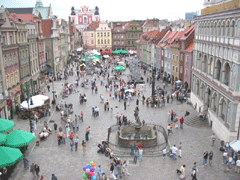
The historic city of Poznan, Poland will host talks on the future of climate change.
GELLERMAN: From the Jennifer and Ted Stanley studios in Somerville, Massachusetts, This is Living on Earth. I’m Bruce Gellerman, in for Steve Curwood.
Poznan, Poland is the place to be if you want to help save the planet from climate change. For 12 days in December, Poznan plays host to eight thousand delegates from 190 countries, there to discuss what should happen when the Kyoto Protocol comes to an end in 2012. Kyoto committed most industrial nations - except the US - to deep cuts in greenhouse gas emissions. Progress has been a mixed bag, but now a global economic meltdown and a change of administration in Washington dramatically alter the climate for a new treaty.
Jennifer Morgan is director of global climate change for E3G. It’s a think tank that focuses on international sustainable development and she’s on the phone from Berlin. Thanks for joining us, Ms Morgan!
MORGAN: Thank you.
GELLERMAN: So what are your expectations of what’s going to happen at the twelve days of Poznan?
MORGAN: Well I think my expectations are that the negotiations will be moved forward hopefully with a new sense of hope and momentum. This meeting falls within a two year negotiating time frame from Bali when the new round was launched last year to Copenhagen when agreement is scheduled to be reached in December of 2009. So it’s a bit of a middle kinda of a stock taking meeting. But hopefully one which will provide some hope for us moving forward in the final year of negotiations.
GELLERMAN: But no concrete treaty or agreements?
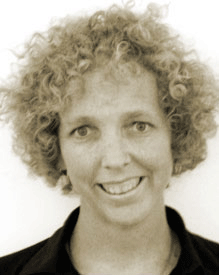
Jennifer Morgan.
GELLERMAN: But you know it’s interesting because the world hasn’t even met the commitments to cut emissions under Kyoto.
MORGAN: I think in the end we’re now just in what’s called the commitment period when countries are implementing their plans, and it is true that countries are not doing enough to reduce emissions, but I am feeling pretty confident that the European Union will meet its commitments, that Japan will meet its commitments and that pretty much all of the industrialized countries, perhaps except for Canada, will in the end meet the targets that they agreed upon in Kyoto. We’re just in the middle or kind of getting started on that. We’ll know in 2012.
GELLERMAN: But Italy’s emissions are actually up 13 percent. The United States, which is not a signature to Kyoto, had and increase of 14 percent over 1990 levels.
MORGAN: Yes. I think Italy and part of the European Union they – the way that the Kyoto Protocol works, is that countries should reduce as much as possible or meet the substantial part of their reduction targets domestically, through domestic reductions, but they are also kind of a made in the USA proposal that was brought into Kyoto allowed to invest in projects in developing countries that reduce emissions and then use those credits that they generate from those projects towards meeting their own targets. So it’s a bit of investment in developing countries. And I believe that Italy has a pretty ambitious program on that in order to make up a gap of what it hasn’t done domestically, so. And as far as the United States goes, well, that is the big question is how the new Obama administration will hopefully come in and turn around the tide of rising emissions in the United States.
GELLERMAN: Of course, Mr. Obama is not going to Poznan, nor is he sending a delegation there.

The historic city of Poznan, Poland will host talks on the future of climate change.
GELLERMAN: You spoke of hope and momentum – how much is pie in the sky? Yvo de Boer who is the head of the climate change secretariat for the United Nations has said that lower oil prices will mean less of an incentive to invest in renewables. The economies of the world are tanking. Will companies and countries want to invest in costly emission cuts?
MORGAN: Well I think that’s - number one, I think when you look at the state of the economy today and the types of short term, initial actions that can be taken to curb the climate crisis, you actually see quite a lot of opportunity. Because the things that we need to do to slow down global warming are things that save energy. For example, if you’re looking at the government pumping billions of dollars into the economy, then it would make a lot of sense for that money to be going into new train systems in the United States to get cars off the road and reduce dependency on oil and curb emission. Energy efficiency programs for low income housing to save money, create new jobs. Leaders really have to have all of these goals in mind. They cannot operate in a business as usual world any more where we just continue to pump money into old technologies, whether they be cars or infrastructure or anything else.
GELLERMAN: Do you expect the United States will become a signature to a new climate treaty next year?
MORGAN: I do expect that. I certainly hope it. I think that the way these negotiations were launched last year, even with a Bush administration, they were done so in a way that there is a space for the United States to engage, both in looking at what it’s own emission reduction targets could be, but also how it could cooperate globally with other countries to move forward on tackling climate change and building the base for a low carbon economy.
GELLERMAN: Ms. Morgan, you’re an optimist.
MORGAN: Well, I’m a tremendously worried optimist. [LAUGHS] I think I am optimistic seeing what a new U.S. president could do to transform this debate internationally. But I think that the moment is hopefully there where the economic realities come together with the scientific realities to move forward. That doesn’t mean that this isn’t a massive challenge that won’t require all of us to come together and try to tackle it, but I think that the issue is so fundamental to the future of the planet, that my hope is that leaders will get it.
GELLERMAN: Well, Ms. Morgan, thanks a lot. I really appreciate it.
MORGAN: You’re very welcome.
GELLERMAN: Jennifer Morgan is director of global climate change for the think tank, E3G.
Related links:
- Third Generation Environmentalists
- For more on the conference in Poznan, click here
Deforestation Nations
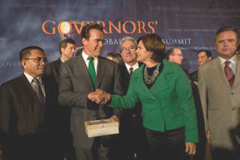
California Governor Arnold Schwarzenegger joined governors from around the world in signing a Memorandum of Understanding to reduce forestry-related greenhouse gas emissions. (Courtesy of the Office of the Governor)
GELLERMAN: One of the most powerful tools in the fight against climate change is the tree. A tree removes carbon dioxide from the atmosphere during photosynthesis and stores it. But if you cut a tree down the CO2 is released back into the air, which is why the world needs to preserve its vast tropical forests - cutting them down releases 20 percent of global carbon dioxide emissions each year. Now, in a bid to curb deforestation governors from tropical regions have joined with their American counterparts. Living on Earth’s Ingrid Lobet reports.
There's one contributor to climate change that's attracted more attention recently: Deforestation. About twenty percent of the greenhouse gases generated on earth come from carbon released from cutting tropical forests. As Living On Earth's Ingrid Lobet reports, governors of tropical forest regions are beginning to join with their American counterparts to stop the cutting.
LOBET: It's no secret that many US state officials are frustrated by the federal government's lack of action on climate change. Some states have been moving ahead with policy on their own.
And in recent days, three U.S. governors, led by California's Arnold Schwarzenegger, went one step further: They held state-to-state talks with governors of major rainforest provinces in Brazil and Indonesia. Peter Seligman of Conservation International noted the occasion.
SELIGMAN: This is an absolutely remarkable gathering, one of those tipping point moments, when you have the governors of the states that control over 50% of the tropical forests on earth gathering with governors of Wisconsin, California and Illinois.
LOBET: At a climate summit in L.A., the Brazilian, Indonesian and American states, signed an agreement to cooperate to preserve tropical forests. They also agreed to work together on the sticky issues of quantifying and monitoring what's being preserved. Forests hold an immense amount of carbon. If tropical regions can guarantee forest protection, they can sell carbon credits to U.S. industry. The devil, all agree, is in the technical details.
SELIGMAN: How do you come up with real, measurable, permanent and verifiable agreements?
LOBET: The presence of governors from Indonesia and Brazil was significant because these two countries are among the top five emitters of CO2 in the world. China and the U.S. rank one and two. And nearly ALL of Indonesia and Brazil's emissions come from forest loss. Governor Eduardo Braga heads the largest forested state in the world, Amazonas in Brazil.
BRAGA: It's like 2.5 times the size of Texas.

California Governor Arnold Schwarzenegger joined governors from around the world in signing a Memorandum of Understanding to reduce forestry-related greenhouse gas emissions. (Courtesy of the Office of the Governor)
BRAGA: Who lives by the forest, they are the really guardians of our environment. They have $1000 per year per capita income, so they are really poor.
LOBET: Braga says he needs no convincing that working together with industrialized nations is essential. In fact, he says, it's overdue.
BRAGA: The last 20 years our people are waiting for new answers from the world about the forest. Because the world has been asking us: How can we cut the deforestation in Amazons? But the world must ask how the local people can improve the standard of living they have over there.
LOBET: Braga is already working with the Marriot Hotel chain on one income-producing forest protection project. Ana Julia Carepa is governor of the neighboring Brazilian state of Para, where deforestation has been rampant. Satellite monitors are now a help. But she says she awaits the day when her residents can make more money protecting the forest than cutting it.
CAREPA: We want to create reforestation as an economic alternative. We want to reforest one billion trees in five years.
LOBET: The governor of the Indonesian province of Aceh has already struck the first rainforest-for-carbon credit agreement with a conservation group. Yusuf Irwandi, says he's shown it's possible to stop logging altogether, and bring down the rate of poverty.
IRWANDI: When I took office in 2007, I announced the moratorium on logging, still in affect. There are so many concession-holders who want to go chop again my forest. I stop them.
LOBET: The governors face skepticism over the idea of cash for credits. The European Union wants to hold off on forest credits until monitoring and anti-fraud measures develop further. And some indigenous advocates are concerned that forest credits could mean newly valuable forest could be taken away from native people.
But the Indonesian, Brazilian and US governors at the summit say they're pleased to be one step closer to admitting forest credits into an American carbon market.
They hope their state-to-state diplomacy will send a message to national level leaders at climate change talks in Poznan and later Copenhagen, that the issue of forest carbon is not too hot to handle.
For Living on Earth, I’m Ingrid Lobet in Los Angeles.
Related link:
To read California Governor Arnold Schwarzenegger’s speech, click here
MUSIC: Santana “Full Moon” from Multi-dimensional Warrior (Legacy Records 2008)
GELLERMAN: Just ahead – China gets serious about cleaning up coal. Keep listening to Living on Earth!
MUSIC: Ray Bryant “Hot Turkey” from Hot Turkey (The Definitive Black And Blue Sessions 1975) (Black And Blue Disques 2007)
Turnaround in Shanxi
GELLERMAN: It’s Living on Earth, I’m Bruce Gellerman.
[SOUNDS OF MINERS LEAVING WORK]
GELLERMAN: It’s the changing of the work shift at China’s giant coal mine in Shanxi Province. Miners emerge from deep underground, their faces and clothes black with coal dust. The province contains a third of China’s coal reserves. Back in the 1980s, Shanxi became the nation’s energy powerhouse - driving China’s phenomenal growth but polluting the region’s air, water, and soil and poisoning the lungs of miners and residents.
Now the local government is trying hard to get Shanxi off the country's environmental blacklist. From Shanxi Province, Elise Potaka reports.
[SOUNDS OF WATER-SPRAY TRUCK PLAYING HAPPY BIRTHDAY, TRAFFIC]
POTAKA: To the melody of happy birthday, a truck winds its way through the streets of Linfen, spraying water on the road to settle the dust and pollutants.
It's a small act which highlights the city's problems.
For three years running, the nation's environment authority deemed Linfen, in the south of Shanxi Province, China's most polluted city.
It's also one of the ten worst polluted cities in the world, according to the Blacksmith Institute.
[SUBURBAN SOUNDS AND VOICES]
POTAKA: From his modest house on the edge of town, Wang Zhang points down the lane.
WANG: The air pollution here is very bad. In the afternoon, even people standing just over there, you can't see them clearly.
POTAKA: Wang's neighbor,Yang Chun Xiang, chimes in. She's in her 70's and says the air is not clear like it used to be when she was a child.
YANG: The air pollution is bad and there are more and more people getting sick. Health is not very good, there's no chance for people here to be fit and well.
POTAKA: And while Linfen might be the worst, it's certainly not the only polluted city in Shanxi.
[CITY SOUNDS]
POTAKA: The province's capital, Taiyuan, is covered in a brown layer of smog. The land here is a patchwork of farmland, coal and bauxite mines, power stations, chemical factories and metal foundries.
[CARS, FISHING MEN TALKING]
POTAKA: The Fen River is the heart of Taiyuan, running right through the center. On a bridge crossing the river, signs are posted saying "no fishing." Three locals dangle fishing lines into the water below. Just not far away dead fish drift, their white bellies turned skywards.
[MEN’S VOICES]
POTAKA: The fishermen say they aren't worried about pollution, and that the fish are okay to eat. But Cao Haixia, a researcher from the Shanxi Energy Economic Research Institute says the Fen River is far from healthy.
CAO: The Fen River is severely polluted. In the 40s and 50s, the river's water level was really high and boats could travel up and down it. Now, many of its tributaries have dried up. In Shanxi, 70% of waterways are polluted, 50% of these are seriously polluted and can't be used.
POTAKA: And Cao also backs up the assertions of the people in Linfen who say air quality has deteriorated there.
CAO: Atmospheric pollution is very serious and respiratory illnesses in Shanxi are common. Cancer rates amongst residents are also high.
POTAKA: But with Linfen's pollution drawing international attention to Shanxi, the Chinese central government and local authorities have rolled into action.
They've installed scrubbers on coal-fired power plants, closed mines and older factories, and now they’re trying out a new tax program with the coal industry. Cao Haixia explains.
CAO: Every company, for every ton of coal they sell, for example, has to put aside about $1.50 US. This money is then used for reducing pollution, and protecting the environment.
[TRAFFIC SOUNDS, MEN TALKING]
POTAKA: And in some big cities, including Linfen, some locals say the environment is improving. These workers building a road in Linfen say many of the worst factories have closed, and the air is much better than two or three years ago. Taxi driver Xiao Hui sees the same thing. At least now he says he can see the sun.
XIAO: Before, we'd get up in the morning, but we couldn't see the sun. It was always dusty. Now lots of factories have been shutdown, this year and last year.
POTAKA: The Ministry for the Environment this year announced that Shanxi's sulphur dioxide emissions decreased more than 6% between 2006 and 2007. The discharge of organic pollutants also decreased.
The Shanxi provincial government is also offering direct rewards to city leaders. If they manage to get off the country's list of top five most polluted cities, they will receive a $146, 000 dollar, reward. They hope this will discourage leaders from being tempted to take bribes.
[STREET SOUNDS]
POTAKA: But with polluting mines and factories closing, some locals are worried about jobs. Shanxi's counties rely on coal to support their economies. Mining and industry money has, in recent decades, lifted the living standards of many residents.
Now some say it's hard to find work. Mrs. Zhang sells snacks on the street to earn money.
ZHANG: I'm 72 years old and I have five children. They haven't got work, there's nothing we can do. Even the coal mines don't want people now. Lots of people here have no work.
[CHILDREN PLAYING, RESIDENTS TALKING]
POTAKA: In areas outside the cities, life can be even tougher.
[WOMEN TALKING]
POTAKA: This villager says neither she nor her husband have work. And she says the air here is still just as polluted as before. No one cares about life in the villages, she says.
The situation here is symbolic of China's larger struggle to lift people out of poverty whilst protecting the environment. Change is happening, but the government admits that the benefits aren't always evenly distributed.
But if a place with as many challenges as Shanxi can manage to successfully transform its environment and economy, it could act as a blueprint for the rest of the country.
For Living on Earth, I’m Elise Potaka in Shanxi.
Cool Fix for a Hot Planet
GELLERMAN: Coming up –robosaurs roam the aisles of toy stores - dinosaurs get a new lease on life thanks to robotics – but first, this cool fix for a hot planet from Jessica Ilyse Smith.
SMITH: Hawaii is leading the race to use the sun's rays to heat household water. With so much sun, and nearly all its fuel imported, the state has much reason to put down the oil and soak up the sun.
[COOL FIX THEME]
Hawaii’s legislature has passed a measure requiring all new homes to have solar rooftop water heaters, beginning in 2010. This puts Hawaii in the lead for solar hot water. Most people in Hawaii have electric hot water heaters. And, unlike most other states, Hawaii gets almost 75 percent of its electricity from petroleum-powered plants. Water heating can account for nearly a third of a homeowner’s electric bill in Hawaii, so going solar could mean sizeable monetary and petroleum savings.
Each day several places within the state receive 450 to 500 calories worth of solar radiation per square centimeter. If that energy were converted to gasoline, it would roughly equal 15 gallons a day from the average-size rooftop. So, Hawaii has the potential to make a real dent in its reliance on fossil fuel.
Not everyone is happy with this move. Some people fear the bill could lead to a slew of hastily–built systems of poor quality. And, some are concerned solar heaters will drive up the price of housing. Even with these questions, this bill will bring much attention to sun-heated water.
For now, with some areas of Hawaii boasting up to 300 days of sunshine a year…it seems like the perfect place to go out and catch some rays.
That’s this weeks Cool Fix for a Hot Planet; I’m Jessica Ilyse Smith.
MUSIC: Cloud Nine/Various Artists “Twenty Twenty (Mad Dog Mix) from Acid Jazz Rarities (Acid Jazz Records 2004)
GELLERMAN: And if you have a Cool Fix for a Hot Planet, we'd like to know it. If we use your idea on the air, we'll send you a sleek cool-blue Living on Earth tire gauge. Keep your tires properly inflated and you could save over $280 a year in fuel costs. That according to a study done at Carnegie Mellon University. Call our listener line at 800-218-9988, that's 800-218-99-88. Or email coolfix—that's one word—at loe.org.That's coolfix at loe.org.
Prehistoric Pets
GELLERMAN: There was a time - seems like eons ago - when toys were simple and fashioned from wood, cloth, metal and paper - but times have changed and toy technology has evolved. The Japanese toymaker Ugobe is one of the companies leading the way with a new generation of toy-asaurus as Spectrum Radio’s Prachi Patel-Predd reports.
PATEL-PREDD: When Ugobe announced that Pleo the robotic dinosaur would hit store shelves in late 2007, parents of pet-loving kids rejoiced. No more hair on the couch or litter-boxes to clean. Puppy-sized Pleo would be an ideal pet: cute and friendly, without the needs of a live animal. Twelve-year old Nadya Nee was intrigued.
NEE: Pleo could walk around and it wouldn’t walk off the table we tested that a lot and it would squirm when you hung it by its tail and it would also sometimes skid like when it would go on the wood floors and you could tickle its feet.
PATEL-PREDD: California-based Ugobe calls its products Life Forms. The company’s goal is to create lifelike creatures using state-of-the-art robotics technologies.
[PLEO’S AUDIO]
PATEL-PREDD: Pleo has six microprocessor chips, a camera, fourteen motors, two microphones, and eight skin sensors. It responds to touch and voice, cries when it’s hungry, goes to sleep when it’s tired, and likes to cuddle.
[PLEO’S AUDIO]
PATEL-PREDD: As 9-year old Mischa Nee found out, Pleo can also occasionally surprise you.
NEE: Once she snuggled up with one of my stuffed animals and fell asleep with it and then one other time when she was in my room she stood on two legs and said Ta-da.
[PLEO’S AUDIO]
PATEL-PREDD: Pleo is turning out to be one popular dinosaur robot. And it seems to have set off a trend.
RICE: Oh there’s absolutely a dinosaur toy trend this year. This year there’s a lot of dinosaurs that are robotic playmates.
PATEL-PREDD: Reyne Rice is a toy trends specialist for the Toy Industry Association. She says that many parents are looking for science and discovery toys. Dinosaurs fit the bill. And all the better if kids can interact with them.
RICE: Kids are growing up looking for interactive toys that will react to them and parents are looking for products that actually respond to a child and the child can actually use their imagination to play with.
PATEL-PREDD: Now other major toy-manufacturers are looking for a piece of the pie. Take Spike the Ultra dinosaur from Mattel’s Fisher-Price division, which you can pre-order online.
[SPIKE’S AUDIO]
PATEL-PREDD: Remote-controlled Spike is designed for three to eight year olds. It stomps around, roars, rears up its front legs, and flashes the spikes on its back. Then there’s the D-Rex, which Mattel calls the ultimate pet for boys. D-Rex is ferocious and loyal. It responds to voice and touch, makes over 100 noises, wags its tail, and even guards its owner’s room. Do you want more cute and cuddly options? Nothing says cute more than a soft, gentle baby triceratops.
[KOTA’S AUDIO]
PATEL-PREDD: Playskool’s Kota the Triceratops moves its head, blinks and roars. And it’s life-size, so kids can hop on and pretend to ride it.
[KOTA’S AUDIO]
PATEL-PREDD: All that fancy robotics come at a price. Kota costs about 300 dollars, while Spike and D-Rex are about 150 dollars apiece. Pleo - the most sophisticated of the bunch - tops the list at about 350. A recent free software download from Ugobe’s website gives the toy the ability to learn. So every Pleo can develop a unique personality based on how it’s treated. One problem with Pleo so far seems to be the rechargeable battery that runs for about half an hour and then needs a three-hour recharge. And even with all the bells and whistles, the creature’s appeal is limited.
NEE: I thought it was cool when I first got it but after playing with it for a while it sorta got really repetitive.
PATEL-PREDD: But if your kids ask for a pet this year, and you dread the care, feeding and cost of a real animal, a robot dinosaur just might be the easy way out. For Living on Earth, I’m Prachi Patel-Predd.
GELLERMAN: Could be a perfect pet for the White House!
Our story on robotic dinosaurs comes to us courtesy of Spectrum Radio, the broadcast edition of IEEE Spectrum, the magazine of technology insiders.
Giving the Gift of Green
GELLERMAN: Maybe a robo-saurus isn’t what Santa has in store for you this year – perhaps you’re looking for something ever-greener – something more environmentally sound.Well, the folks at Living on Earth have made a list – and checked it twice.
[MUSIC]
LARSON: My suggestion for a green holiday gift is a wallet or bag from Used Rubber USA. They make their products from recycled rubber tires. I cary a tiny purse that I bought from their original store on Haight Street in San Francisco years ago. It’s just the right size for some cash, a few cards and a subway pass. It’s sleek, water proof and recycled. What could be better?
[MUSIC]
MARTIN: I like to give my family gifts from Heifer Project. It’s an organization that gives livestock to needy people around the world so that they can grow their own food and provide for themselves. The way it works is that I give a donation and my family gets a card saying I’ve bought bunnies or geese or honey bees in honor of them.
[MUSIC]
AHEARN: This year I’m going to make my friends mix cds because I don’t get to spend a lot of time with them, but it’s a way for them to know what’s playing in my head phones even if they’re on the other side of the planet.
[MUSIC]
PALMER: I am a keen gardener, so I like to both give and be given seeds. They’re always welcome for me. And if you like to garden, one thing you can do is pot up crocuses, iris, daffodils, paper whites, hyacinth, lily of the valley, scilla any of those things, you can put in little pots and they’ll flower early in the year.
[MUSIC]
TAJ: At nativeseeds.org you can buy your loved ones a packet of seeds that will grow traditional crops. It’s a unique, affordable gift that’ll help support crop diversity and indigenous communities.
[MUSIC]
GELLERMAN: My idea of the perfect holiday gift is something that requires no batteries, no plastic, no assembly and will bring joy day after day and year after year. They’re renewable and each is unique with lots of choices. There are those that provide food, keep you cool in summer and warm in the winter. They all clean the air from pollutants and they measure the passage of time. How about giving a tree?
[MUSIC]
BASCOMB: My suggestion is BoGo flashlights. They’re powered by a solar panel and will last you at least three or five years. And for everyone that you buy at $39, a second one is sent to a community in the developing world. They send them to places like refugee camps or orphanages in Africa.
[MUSIC]
YOUNG: You know what they say about a guy with a big carbon footprint? That’s right – he needs a carbon offset. Several companies will gladly take your money and invest it in clean energy projects. In return you get a certificate showing that you have effectively cancelled out the greenhouse gases from say someone’s holiday travel. If you really want to have fun with it, you could wrap it around a lump of coal for the perfect stocking stuffer.
[MUSIC]
GELLERMAN: Living on Earth’s 2008 Green Gift Guide was produced by technical director Jeff Turton.
Related links:
- Native Seeds/SEARCH: Ancient Seeds for Modern Needs
- Bogo Light Flashlights
- Living on Earth’s coverage of the Solar Powered Flashlight
- To learn more about Carbon Offsets, click here….
- … or here
- and for a skeptical view of the value of carbon offsets, click here
- Used Rbber USA
[MUSIC: Various Artists/Bing Crosby “Happy Holidays (Beef Wellington Remix) from Christmas Remixed (Six Degrees Records). Various Artists/Joe Williams “Good Morning Blues (Real Tuesday Weld Remix” (Verve Christmas Remixed (Verve Records 2008). Various Artists/Nina Simone “I Am Blessed (Wax Taylor Remix” from Verve Christmas Remixed (Verve records 2008). Ming & F.S.: “Snowflakes Falling”. Various Artists/Kay Starr “I’ve Got My Love To Keep Me Warm (Stuhr Remix) from Christamas Remixed (Six Degrees Records). Berlin Symphony “Dance Of The Sugar Plum Fairy (Red Baron Remix)” from Christmas Remixed Vol 2 (Six Degrees Records 2004)]
Coming up – A rare breed of farmer tends her endangered flocks.
[TURKEY SOUNDS]
CERMAK: So typically a commercial farm might raise all one bird – like a New Holland – so what we might do next season is bring in a chocolate turkey which is on a critical list.
GELLERMAN: Saving our heritage one turkey at a time. Keep listening to Living on Earth.
ANNOUNCER: Support for the Environmental Health Desk at Living on Earth comes from the Cedar Tree Foundation. Support also comes from the Richard and Rhoda Goldman fund for coverage of population and the environment - and from Gilman Ordway for coverage of conservation and environmental change. This is Living on Earth on PRI, Public Radio International.
[MUSIC: Skeebo Knight: “Turkey On Bourbon Street” from Cool Diggs (Skeebo Knight Music 2005)]
Bright Lights, Big City

An artist’s rendering of what the billboard will look like when it is complete. The wind turbines are in columns on either side of the billboard. The solar panels are above. (Photo courtesy of Ricoh Americas Corporation)
GELLERMAN: It’s Living on Earth, I’m Bruce Gellerman. It was poet Ogden Nash who wrote “I think that I shall never see a billboard lovely as a tree.” Well, if Ogden Nash were alive now to take a trip to Times Square in New York City – he might get quite a surprise - as Living on Earth’s Jessie Martin reports.
[SOUNDS OF TIMES SQUARE]
MARTIN: Times Square – there’s nowhere else in the world quite like it. Stand on the corner of 7th avenue and 42nd street, look in any direction, day or night, and you’ll face a wall of flashing billboards and glowing LED screens.
[SOUNDS OF TIMES SQUARE]
MARTIN: Some people love it.
WOMAN: I’m from New York, New York City. And I love Times Square. It’s awesome. Action, energy, everything. Awesome.
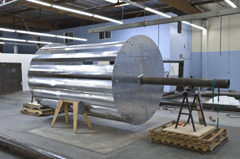
A wind turbine during its production in the PacWind facility in Torrance, CA. (Photo courtesy of Ricoh Americas Corporation)
MARTIN: And some don't.
MAN: Oh my good Lord. During holidays avoid it at all costs. If I have a choice I don’t go to midtown.
MARTIN: But starting in December, there’ll be a new glowing billboard in Times Square - one that really stands out - and not because it’s the biggest or the brightest.
POTESKY: It's the first of its kind so it is completely unique. And it will be you know 100% driven by wind and sun and it will shine hopefully a very bright light on Broadway.
MARTIN: That’s Ron Potesky, a senior vice president for marketing at Ricoh, the company that’s building the eco friendly sign. Sixteen wind turbines will be stacked in towers on either side of the billboard. They’re specially designed to use the quirky winds in Times Square, and they work at wind speeds as low as 5 miles an hour. And Potesky says the billboard will also use any sunshine that makes it into the Square thanks to 64 solar panels placed along the top of the sign.

An artist’s rendering of what the billboard will look like when it is complete. The wind turbines are in columns on either side of the billboard. The solar panels are above. (Photo courtesy of Ricoh Americas Corporation)
MARTIN: But Potesky doesn’t think that the billboard will go dark too often because it's equipped with batteries that can save up enough energy from the sun and wind to power the sign for four cloudy, still days.
Ricoh estimates that running their billboard on wind and solar energy will save them twelve to fifteen thousand dollars a month in energy costs, but Potesky insists that saving money isn't the company's main aim.
POTESKY: The reason we've developed this ecoboard is to try to promulgate the idea that companies can be responsible and that companies can be creative in the way they save energy. So of course a company like Ricoh or any other large company - we advertise - and we don't think our advertising should leave you know one ounce of carbon to hurt the environment.
MARTIN: In fact, Ricoh estimates that by running their billboard on renewable power, they will prevent 18 tons of carbon dioxide from entering the atmosphere every year.
And that impressed at least one New Yorker.
MAN: If I knew that this wasn’t a big electric bill going on here, I don’t think I would be as anti-Times Square.
MARTIN: The Ricoh billboard is scheduled to have it’s grand opening on Thursday, December 4th - if the weather cooperates.
For Living on Earth, I'm Jessie Martin.
Related link:
Ricoh Americas Corporation
E-I-E-I-Endangered
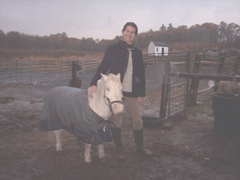
Jennifer Cermak with Sugar the mini horse (Photo: Bruce Gellerman)
[ROOSTERS]
GELLERMAN: You have to wake up pretty early in the morning to beat Jennifer Cermak to work. She’s up before the sun to tend to her animals.
[ROOSTERS]
Jennifer Cermak is a fourth generation farmer - which makes her something of an endangered species, less than two percent of Americans live and work on a farm or ranch.
Fewer still are women - and even rarer is the farmer who raises endangered farm animals which Jennifer Cermak does at Berlin Farms, about 40 miles west of Boston.
At Berlin, she’s turned an old barn into a farm stand and restaurant, and out back she raises rare chickens, turkeys, rabbits, horses and sheep that are small in number but long on heritage.
CERMAK: Believe it or not but there are a lot of endangered barnyard animals because there are so few small farms in existence. There are a lot of commercial farms that will carry one breed, for example, one breed of New Holland turkey but because there was a great breed diversity in the mid to late 1800s, we’ve lost that breed diversity as we’ve gone to large, commercial farms.
GELLERMAN: So you’re protecting endangered farm animals?
CERMAK: Yes. I think most people think in terms of endangered rainforests, endangered African wildlife, and they don’t realize that this is a problem in their own backyard.
GELLERMAN: How big a problem? And, I haven’t noticed it, to be honest with you.
CERMAK: Sure. And that’s because most people don’t live in an agricultural zone and have the hands-on access and experience to what’s going on in those farms. For example, one of our chickens—there’s probably only 500 left in the United States, which puts them on a critical list.
GELLERMAN: What kind of chickens?
CERMAK: They’re called Sumatra. They’re a big—or a smaller, very fancy-looking, black chicken.
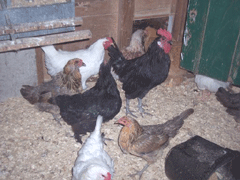
Fewer than 500 of these rare Sumatra chickens exist in the country today. (Photo: Bruce Gellerman)
CERMAK: Absolutely.
[SOUND OF FOOTSTEPS AND DOOR OPENING]
CERMAK: We’ll have to see who’ll come out. Because of the rain, I think everyone wants to stay indoors dry. We’ll go fish him out.
[DOOR OPENS]
GELLERMAN: Whoa, look at those birds!
CERMAK: So if you see the big fancy black ones with the long tails—the three of them. Those are Sumatras. And right here we have a Speckled Sussex and a Rhode Island Red.
GELLERMAN: The Sussex—is it rare?
CERMAK: Yes, they are. All of these are on watch lists, either critical or endangered, based on their numbers in the United States.
GELLERMAN: Where do you get them from?
CERMAK: So you have to buy birds—in the state of Massachusetts—from people that have licensed approval. You can’t just ship birds across state lines—
[ROOSTER CROWS]
CERMAK: -- from non-accredited hatcheries.
GELLERMAN: What are you going to do with them? Are you going to breed them or am I going to have it in a potpie someday?
CERMAK: (laughs) Right. So, this is a no-kill farm. So what we do is sell the chicken eggs. So we sell chicken and turkey eggs. And we also use it in our baking. We have a brunch service Monday through—uh, Saturday and Sunday. And we use the eggs in omelets and pies, things like that.
[ROOSTER CROWS]
GELLERMAN: They really do that.
CERMAK: They really do. And they start at about 3 o’clock in the morning. So I think one starts and the others start challenging it and it goes from there all day. (Laughs) So you don’t want to have very close neighbors.
GELLERMAN: So what are these animals here? I’ve never seen—what is it a turkey or something?
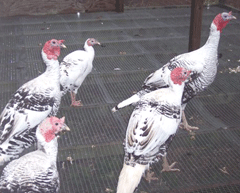
Jennifer's royal palm turkeys. Only around 10,000 of this breed exist in the country. (Photo: Bruce Gellerman)
GELLERMAN: And what do you do with them?
CERMAK: We use their eggs. They have a really nice, big egg. It’s great for baking. It tastes like a chicken egg. You can’t really see but they have a—if they turn around, they have a beautiful blue face and an orangish red head. And they’re very docile. I mean, one thing you find out quickly when you’re raising different kinds of birds and chicken—is that some are inherently a little nastier than others and some are just sweet as pie. These guys are really friendly. I hand raised them. Hi guys!
[TURKEYS CHIRP]
CERMAK: So typically a commercial farm might raise all one bird, like a New Holland. So what we’ll be doing next season is bringing in most likely a chocolate turkey, which is on a critical list. So, because we’re not required to provide a thousand turkeys for the holiday season for table, we have the ability to bring in a few rare turkeys and raise them and breed them and let them live out their life expectancies and provide eggs.
GELLERMAN: You know, you’re solving a problem I never knew we had.
CERMAK: Yes, I think a lot of people aren’t exposed to agriculture like they were before. One of the difficulties in running a farm like this is being able to find people that have the know-how, that aren’t afraid of chickens, that know how to take care of horses.
GELLERMAN: So they’re endangered, too.
CERMAK: Yes, people that have farming experience, that know when an animal is sick or okay, it’s very difficult to find. So, I’m going to show you the Southdowns. The Southdown sheep are recovering, which is also fantastic. They were an endangered breed as well. We’re just going to grab some hay and go feed them. And you’ll find what’s neat about them is they’re extremely docile and part of what makes your farming easier if you’re dealing with animals that aren’t going to give you any trouble, that aren’t going to ram you when you’ve turned around and aren’t looking. That’s quite unpleasant.
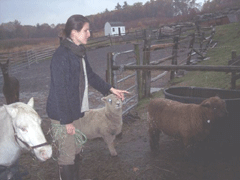
Jennifer with her Southdown sheep. (Photo: Bruce Gellerman)
CERMAK: (laughs) Sorry.
GELLERMAN: Oh my!
CERMAK: That’s right. This is the menagerie.
GELLERMAN: Holy cow. That’s—an alpaca?
CERMAK: That’s an alpaca and his—he’s a South American animal originally and he’s not endangered. He keeps the sheep safe. So, coyotes don’t like alpacas. We have a ton of coyotes here. So the alpaca guards the herd.
[GATE OPENS]
CERMAK: You’re a good boy!
GELLERMAN: So what will you do with the sheep?
CERAK: So we’re going to breed them as well.
GELLERMAN: Jennifer, if you could have one pair of animals that is endangered, what would it be?
CERMAK: Oh um—
[BELL RINGS]
CERMAK: I would have to say, and this is just because I was one of those schoolgirls that took lessons out of elementary school, it would have to be the horses. Um, I just love—there are endangered horses as well. We have a Freisian that is. But you know, I love to ride. So for me it would serve a dual purpose—I’d be able to ride and be helping this cause as well.
GELLERMAN: So is this a lifelong dream for you or you just kind of woke up one day and said ‘you know, I’ve got to go save endangered farm animals?’

Bella the pot-bellied pig at Berlin Farms. (Photo: Bruce Gellerman)
So the other thing I really didn’t know about being a farmer is you need to be a mechanic, and that’s a little hard. So you have to be able to fix your own tractor and I haven’t learned how to do that yet, so that’s my biggest trouble because that thing breaks down every five minutes. So um, what you’re looking at is a Polish. He doesn’t have a lot of meat on him. He’s a smaller chicken.
GELLERMAN: He looks like almost, what, I don’t know what.
CERMAK: He’s very fancy looking. And you can see, which is probably why he is endangered, he’s not one of these big-breasted roasters that falls over on itself. And you can see these birds are a little more delicate than you’d expect at table.

Jennifer Cermak with Sugar the mini horse (Photo: Bruce Gellerman)
CERMAK: He’s called a Polish.
GELLERMAN: How many of those are there in this country, do you know?
CERMAK: Um, they are on a watch list. Maybe about 5,000 if I had to guess.
GELLERMAN: Now, the USDA—
CERMAK: Yes.
GELLERMAN: Does it categorize farm animals as endangered?
CERMAK: Not that I’m aware of. I believe the wildlife and fisheries organization categorizes native animals and most of these breeds were brought over from England, Europe, Asia, 1800s mid to late and that’s when the breed registries were started and we started counting how many of a particular breed that we had. And obviously at that time most people had chickens in their backyard and did maintain some amount of agriculture so you could have breed diversity. And now big commercial farms aren’t interested in maintaining these breeds, obviously because of the economics aren’t there for them. Um, but it is important to maintain breed diversity and to keep not only numbers of a particular bird but flocks of a bird in different areas should a disease break out. That there are a number of breeding areas.
So this is really a treat that this can stay open to the public with people visiting and seeing these kinds of birds. Obviously, with a big, commercial facility you might not want someone off the street walking in and carrying you don’t know what on their shoes, and making a large population of birds sick. I mean, some of these hatcheries have 300,000 birds.
GELLERMAN: So you’re kind of part of agrotourism.
CERMAK: That’s right. That’s right. I’m not sure how many people have heard that phrase but people have very little exposure to agriculture and now that’s a new business—agrotourism. Showing people how to farm, giving them access to animals they’re not allowed to have in their neighborhoods, and providing them a large space that’s serene, where they can come with their families and enjoy themselves.
What’s challenging as an owner of one of these farms is the liability. You’re taking families that may or may not have experience with animals, that may or may not be doing different things that put themselves at risk, whether it’s in the simplest form that they don’t know that they’re looking at a chicken, when they see these chickens. And it’s great you can tell them what they’re looking at. And in other times you just get people that just don’t have judgment and—
GELLERMAN: It’s not wrapped in plastic.
CERMAK: (laughs) That’s right. That’s right. So, these guys have beaks and they peck and they have feelings. And the reason, I believe, that these guys are not very aggressive is because we’re very gentle with them.
[ROOSTER CROWS, CELL PHONE RINGS]
GELLERMAN: What is that?
CERMAK: That’s my phone.
GELLERMAN: Oh, so you do have some modern technology here.
CERMAK: I do, I have my Blackberry from work so it keeps me on schedule. I probably have some reminder popping up about something. What’s good about some modernization is I can find animals across the country that would be very difficult for me to source. So I can go on the Internet and find a rare breed that’s in Texas, I know that there’s a breeder there and talk to them about purchasing one of the animals. Hey gang! What’s going on? This is Bruce!
GELLERMAN: They don’t seem to care.
CERMAK: They don’t seem to care. They’re very inquisitive. I’ll try to see if there are any eggs, if anyone did any work. Nothing. So, that’s another point with the patience that it requires to care for some of these breeds. If you were a commercial chicken, and you weren’t putting out your egg quota because you’re getting older, you’d get put to market. With us, if they have a slow day and they’re not laying as many eggs, that’s okay.
[FOOTSTEPS]
CERMAK: And we’re back to the cow barn.
GELLERMAN: You have big plans.
CERMAK: We do. We have a lot of work ahead of us. We’ve done our winterizing for the animals so they’re ready for winter. Their jackets are all in or ordered and now we’ll spend the winter making the basement look nice.
[MUSIC PLAYS]
GELLERMAN: You already got your music. Is that Christmas music already?
CERMAK: It is. It is. It’s Louis Armstrong.
[MUSIC: Louis Armstrong “What A Wonderful World” from ‘The Joy Of Christmas Past’ (GRP Records—1994)]
GELLERMAN: Oh, yeah. Farmer Jennifer Cermak at Berlin Farms in Massachusetts where she’s raising endangered barnyard animals. For photos check out our webpage: loe.org.
Related link:
Berlin Farms
GELLERMAN: On the next Living on Earth - The Gulf Stream, a river runs thru the Atlantic Ocean.
ULANSKI: And I've been on the Gulf Stream, sailed on the Gulf Stream, worked on the Gulf Stream, dove under the Gulf Stream, and I said, “Hey, might be kind of interesting to take it from a different perspective, a bird's eye view.”
GELLERMAN: I’m Bruce Gellerman – A new book tracks the science, history, and lore of the Gulf Stream. We go with the flow next time on Living on Earth from PRI.
GELLERMAN: Living on Earth is produced by the World Media Foundation. Our crew includes Ashley Ahearn, Bobby Bascomb, Eileen Bolinsky, Ingrid Lobet, Helen Palmer, Mitra Taj and Jeff Young, with help from Sarah Calkins and Marilyn Govoni. Our interns are Sandra Larson and Jessie Martin. Jeff Turton is our technical director. Alison Lirish Dean composed our themes. You can find us at loe.org. Our executive porducer is Steve Curwood.
I’m Bruce Gellerman. Thanks for listening.
ANNOUNCER: Funding for Living on Earth comes from the National Science Foundation, supporting coverage of emerging science, and Stonyfield Farm: organic yogurt and smoothies. Stonyfield pays its farmers not to use artificial growth hormones on their cows. Details at stonyfield.com.
Support also comes from you our listeners, the Ford Foundation, the Town Creek Foundation, the Oak Foundation supporting coverage of climate change and marine issues; the Skoll Foundation, supporting social entrepreneurs around the world – uncommon heroes dedicated to the common good. Learn more at skoll.org; and Pax World Mutual Funds: socially and environmentally sustainable investing. Pax World: for tomorrow. On the web at paxworld.com.
ANNOUNCER2: PRI, Public Radio International.
Living on Earth wants to hear from you!
Living on Earth
62 Calef Highway, Suite 212
Lee, NH 03861
Telephone: 617-287-4121
E-mail: comments@loe.org
Newsletter [Click here]
Donate to Living on Earth!
Living on Earth is an independent media program and relies entirely on contributions from listeners and institutions supporting public service. Please donate now to preserve an independent environmental voice.
NewsletterLiving on Earth offers a weekly delivery of the show's rundown to your mailbox. Sign up for our newsletter today!
 Sailors For The Sea: Be the change you want to sea.
Sailors For The Sea: Be the change you want to sea.
 The Grantham Foundation for the Protection of the Environment: Committed to protecting and improving the health of the global environment.
The Grantham Foundation for the Protection of the Environment: Committed to protecting and improving the health of the global environment.
 Contribute to Living on Earth and receive, as our gift to you, an archival print of one of Mark Seth Lender's extraordinary wildlife photographs. Follow the link to see Mark's current collection of photographs.
Contribute to Living on Earth and receive, as our gift to you, an archival print of one of Mark Seth Lender's extraordinary wildlife photographs. Follow the link to see Mark's current collection of photographs.
 Buy a signed copy of Mark Seth Lender's book Smeagull the Seagull & support Living on Earth
Buy a signed copy of Mark Seth Lender's book Smeagull the Seagull & support Living on Earth

